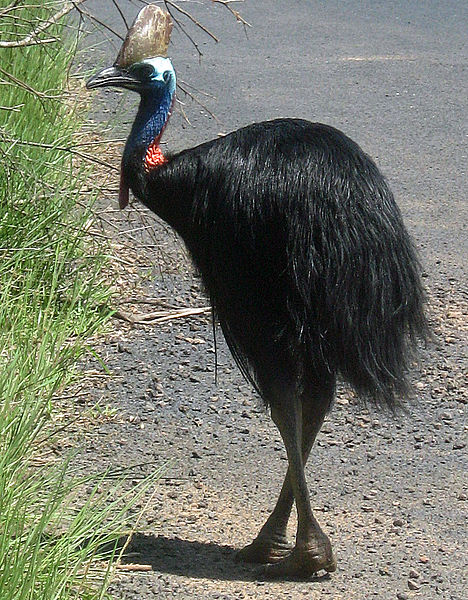Share this page:
Mission Beach is the collective name for four coastal villages dotted along a beautiful 10 km long tropical beach located east of the Bruce Highway between Tully and Innisfail in northern Queensland.
The name Mission Beach comes from the Hill River Mission that operated in the locality until it was destroyed by a cyclone in 1918.
Offshore from beach you can see islands of the Family Group.
Behind the beach and coastal strip are rainforests that are registered as a UNESCO Wet Tropics World Heritage Area. In certain spots the rainforests run right down to the foreshore.

Wild cassowary walking down road in South Mission Beach.
Photo: wvbailey.
These rainforests - for example, Tom O'Shanter State Forest - are a good place to see cassowaries, a rainforest version of the emu. Cassowaries are flghtless birds that have a blue head and neck and a bone-colored, spongy crest.
They live in the tropical rainforests of northeastern Australia and Papua New Guinea. Here in northern Queensland they are an endangered species with less than 2,000 still living there.
These birds are a vital part of the environment, with the fruit of the area's trees being eaten and their seeds distributed by them.
Be aware that cassorwaries are quite aggressive and will attack if feeling threatened - so keep your distance.
The ornithologist Ernest Thomas Gilliard wrote about cassowaries in the book Living Birds of the World: "The inner or second of the three toes is fitted with a long, straight, murderous nail which can sever an arm or eviscerate an abdomen with ease."
And cassowaries are are very fast (they can run up to 50 km/h or 31 mph) and athletic (they can jump heights of up to 1.5 metres or 4.9 ft). They are also excellent swimmers. So don't tease them and think you can just run away if they get angry.
Admire this beautiful and unique bird and treat it with respect!

Licuala palms in a rainforest at Mission Beach. This photo was taken just three months before tropical cyclone Larry in 2006.
Photo: rainforest-facts.com.
The flora of the rainforests is also fascinating , with vines, licuala palms (with their saucer-shaped leaves) and much more.
The four coastal villages of the Mission Beach area are (from south to north):
- South Mission Beach - with the site of the original Hull River Mission and the Kennedy Walking Track (see below for information about the explorer Edmund Kennedy)
- Wongaling Beach - has the area's only pub
- Mission Beach - the main population centre with shops, restaurants, a post office and banks
- Bingil Bay - site of the unique Sanctuary accommodation where you can stay in cabins on stilts nestled amongst the surrounding rainforest canopy (there is only a fine mesh separating you from the forest), all set in 50 acres of thick steamy coastal rainforest with plentiful wildlife (including cassowaries) and a 700 meter walk through the forest to a beach
History
In May 1848 the explorer Edmund Kennedy and his party of 13 men was dropped off by the barque Tom O'shanter and the supply ship H.M.S. Rattlesnake at Tom O'Shanter Point (south of the modern-day South Mission Beach and north of modern-day Cardwell). Their mission was to travel overland to the northern tip of Cape York Peninsula in far northern Queensland near New Guinea.
Unfortunately, all of the expedition members except three died. In December 1848 Kennedy was speared to death by hostile Aborigines at Escape River, just 20 miles short of Cape York Peninsula. Kennedy's faithful Aboriginal companion Jackey Jackey then trekked out of the area and brought assistance for the other two remaining survivors of the ill-fated expedition.
Share this page:
Author: David Paul Wagner
(David Paul Wagner on Google+)
|